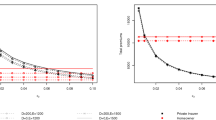Abstract
Dramatic events in the recent past have drawn attention to catastrophe risk management problems. The devastating terrorist attacks of September 11, 2001 incurred the highest insured losses to date. Furthermore, a trend of increasing losses from natural catastrophes appears to be observable since the late 1980s. The increase in catastrophe losses triggered intensive discussion about the management of catastrophic risk, focusing on three issues. First, considering the loss potential of certain catastrophic events, the insurance markets’ capacity does not seem to be sufficient. An approach to address this capacity issue can be seen in passing certain catastrophic risks to investors via securitization. Second, after the events of September 11, 2001, the government’s role as a bearer of risk became an increasingly important issue. Finally, as has been recently demonstrated by the floods in Europe of August 2002, problems of protecting against catastrophic threats do not only exist on the supply side but also on the demand side. Thus policymakers are considering the establishment of mandatory insurance for fundamental risks such as flood and windstorm. This paper addresses aspects of these three issues. In particular, we are concerned with the extent to which state or government involvement in the management of catastrophic risk is reasonable.
The authors would like to thank Brandie Williams for very helpful research assistance. Project support from the Katie School of Insurance and Financial Services at Illinois State University is gratefully acknowledged.
Access this chapter
Tax calculation will be finalised at checkout
Purchases are for personal use only
Preview
Unable to display preview. Download preview PDF.
Similar content being viewed by others
References
Bantwal VJ, Kunreuther HC (2000) A Cat Bond Premium Puzzle? Journal of Psychology and Financial Markets 1:76–91
Baur E, Schanz KU (eds) (1999) Alternative risk transfer (ART) for corporations: a passing fashion or risk management for the 21st century. sigma no. 2/1999. Swiss Re, Zurich
Belonsky G, Laster DS, Durbin D (1999) Insurance-Linked Securities. Swiss Re, Zurich
Berz G (1999) Naturkatastrophen an der Wende zum nächsten Jahrhundert — Trends, Schadenpotentiale und Handlungsoptionen der Versicherungswirtschaft. Zeitschrift für die gesamte Versicherungswissenschaft 88:427–442
Cholnoky TV, Zief JH, Werner EA, Bradistilov RS (1998) Securitization of Insurance Risk — A New Frontier. Goldman Sachs Investment Research
Croson DC, Kunreuther HC (2000) Customizing Indemnity Contracts and Indexed Cat Bonds for Natural Hazard Risks. Journal of Risk Finance 1:24–41
Croson D, Richter A (2003) Sovereign Cat Bonds and Infrastructure Project Financing. Risk Analysis 23:611–626
Cummins JD, Doherty NA, Lo A (2002) Can insurers pay for the ‘big one’? Measuring the capacity of an insurance market to respond to catastrophic losses. Journal of Banking and Finance 26:557–583
Cummins JD, Lalonde D, Phillips RD (2004) The Basis Risk of Catastrophic-Loss Index Securities. Journal of Financial Economics 71:77–111
Dionne G, Doherty NA (1993) Insurance with Undiversifiable Risk: Contract Structure and Organizational Form of Insurance Firms. Journal of Risk and Uncertainty 6:187–203
Doherty NA (1997) Financial Innovation for Financing and Hedging Catastrophe Risk. In: Britton NR, Oliver J (eds.) Financial Risk Management for Natural Catastrophes, Proceedings of a Conference sponsored by Aon Group Australia Limited. Griffith University, Brisbane, pp. 191–209
Doherty NA (2000) Integrated Risk Management — Techniques and Strategies for Managing Corporate Risk. New York
Doherty NA, Lamm-Tennant J, Starks L (2003) Insuring September 11th — Market Recovery and Transparency. Journal of Risk and Uncertainty 26: 179–199.
Doherty NA, Richter A (2002) Moral Hazard, Basis Risk and Gap Insurance. Journal of Risk and Insurance 69:9–24
Durbin D (2001) Managing Natural Catastrophe Risks: The Structure and Dynamics of Reinsurance. The Geneva Papers on Risk and Insurance 26:297–309
Durrer A, ed. (1996) Insurance derivatives and securitization: New hedging perspectives for the US catastrophe insurance market. sigma no. 5/1996. Swiss Re, Zurich
Epstein, R (1996) Catastrophic Responses to Catastrophic Risk. Journal of Risk and Uncertainty, 20:290–304
Froot KA (1997) The Limited Financing of Catastrophe Risk: An Overview. NBER Working Paper no. W6025
Froot KA (1999) The Evolving Market for Catastrophic Event Risk. Risk Management and Insurance Review 2:1–28
Froot KA (2001) The market for catastrophe risk: a clinical examination. Journal of Financial Economics 60:529–571
Greenwald, BC, E. Stiglitz JE (1990), Asymmetric Information and the New Theory of the Firm: Financial Constraints and Risk Behavior. American Economic Review (Papers and Proceedings) 80:160–165
Holmström B (1979) Moral Hazard and Observability. Bell Journal of Economics 10:74–91
Holzheu T, Lechner R (1998) The global reinsurance market in the midst of consolidation. sigma no. 9/1998. Swiss Re, Zurich
Klein RW, Kleindorfer PR (1999) The Supply of Catastrophe Insurance Under Regulatory Constraints. Working Paper. Managing Catastrophe Risk Program, The Wharton School, University of Pennsylvania
Kunreuther HC (1976) Limited Knowledge and Insurance Protection. Public Policy 2:237–252
Kunreuther HC (2002) The Role of Insurance in Managing Extreme Events: Implications for Terrorism Coverage. Risk Analysis 22:427–437
Laster D, Raturi M (2001), Capital market innovation in the insurance industry. sigma no. 3/2001. Swiss Re, Zurich
Müller E (2000) Pluralität der Risikoabsicherungsinnovation. Zeitschrift für die gesamte Versicherungswissenschaft 89:193–223
Munich Re ART Solutions (2001) Risk Transfer to the Capital Markets — Using the Capital Markets in Insurance Risk Management. Munich
Nell M (1990): Die Bedeutung des Risikos als Produktionsfaktor. Zeitschrift für die gesamte Versicherungswissenschaft 76:275–285
Nell M (1993) Versicherungsinduzierte Verhaltensänderungen von Versicherungsnehmern: Eine Analyse der Substitutions-, Moral Hazard-und Markteffekte unter besonderer Berücksichtigung der Krankenversicherung. Karlsruhe
Nell M (2001) Staatshaftung für Terrorrisiken? ifo Schnelldienst 54:6–9
Nell M, Richter A (2001) Alternative Risk Transfer Mechanisms for Seismic Risks. In: Kleindorfer PR., Sertel MR (eds.) Mitigation and Financing of Seismic Risks in Turkey: Turkish and International Perspectives. Dordrecht, pp. 237–253
Nell M, Richter A (2003) The Design of Liability Rules for Highly Risky Activities — Is Strict Liability Superior When Risk Allocation Matters? International Review of Law & Economics 23:31–47
Rees R (2001) Kein Grund für staatliche Intervention. ifo Schnelldienst 54:5–6
Russell DT (1999) It’s a Disaster. Los Angeles
Schwarze R, Wagner GC (2002) Hochwasserkatastrophe in Deutschland: Über Soforthilfen hinausdenken. Wochenbericht des DIW, Nr. 35, pp. 596–600
Shavell S (1979) On moral hazard and insurance. Quarterly Journal of Economics 93:541–562
Sinn HW (1986) Risiko als Produktionsfaktor. Jahrbuch für Nationalökonomie und Statistik 201:557–571
Zanetti A, Enz R, Menzinger I, Mehlhorn J, Suter S (2003) Natural catastrophes and manmade disasters in 2002: high flood loss burden. sigma no. 2/2003. Swiss Re, Zurich
Zanetti A, Enz R, Schaad W (2002) Natural catastrophes and man-made disasters in 2001: man-made losses take on a new dimension. sigma no. 1/2002. Swiss Re, Zurich.
Zanetti A, Enz R, Schweizer U (2001) Natural catastrophes and man-made disasters in 2000: fewer insured losses despite huge floods. sigma no. 2/2001. Swiss Re, Zurich
Author information
Authors and Affiliations
Editor information
Editors and Affiliations
Rights and permissions
Copyright information
© 2005 Springer Berlin · Heidelberg
About this chapter
Cite this chapter
Nell, M., Richter, A. (2005). Catastrophic Events as Threats to Society: Private and Public Risk Management Strategies. In: Frenkel, M., Rudolf, M., Hommel, U. (eds) Risk Management. Springer, Berlin, Heidelberg. https://doi.org/10.1007/3-540-26993-2_16
Download citation
DOI: https://doi.org/10.1007/3-540-26993-2_16
Publisher Name: Springer, Berlin, Heidelberg
Print ISBN: 978-3-540-22682-6
Online ISBN: 978-3-540-26993-9
eBook Packages: Business and EconomicsEconomics and Finance (R0)




